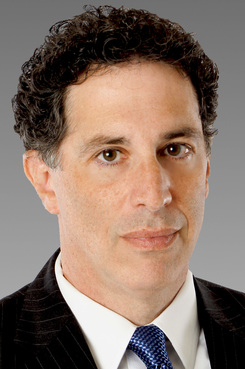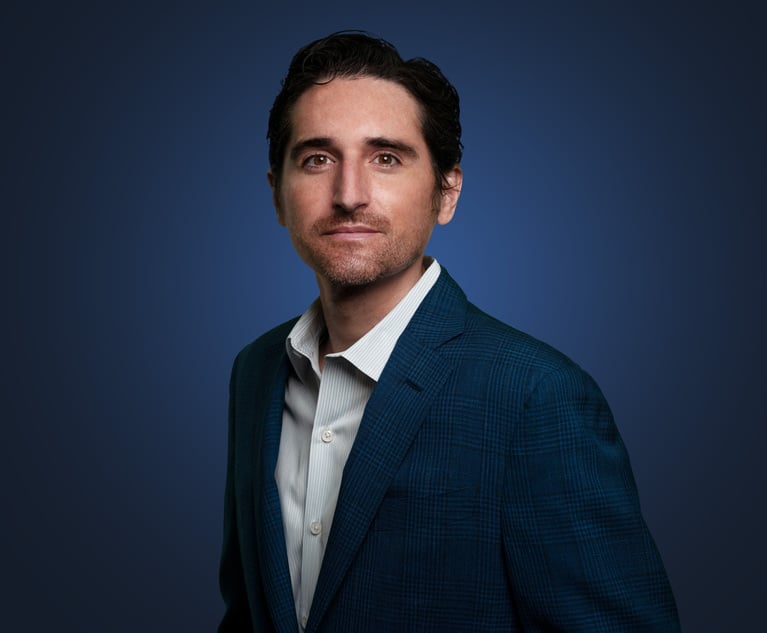Why Get a Patent? It Really Depends on Your Particular Business Model
The numbers are staggering. In 2017, IBM obtained almost 9,000 U.S. patents. If you consider the fact that IBM obtains patents all over the world, you realize that this company consistently spends incredible amounts of money in order to secure intellectual property protection.
August 21, 2018 at 01:07 PM
6 minute read
 Lawrence Ashery.
Lawrence Ashery.
The numbers are staggering. In 2017, IBM obtained almost 9,000 U.S. patents. If you consider the fact that IBM obtains patents all over the world, you realize that this company consistently spends incredible amounts of money in order to secure intellectual property protection.
IBM has numerous strategies in place in order to obtain patents as cost effectively as possible. Nevertheless, huge investments are being made. Why would an organization spend so much money on patent protection? The reasons vary, and will depend upon particular business models.
Patents provide value in numerous ways. Here is how:
Damages
A U.S. patent provides an exclusionary right. The owner(s) of a U.S. patent can exclude others from exploiting (e.g., making, using, selling, etc.) that which has been patented. The value of a good patent policy depends not only on the market where a company desires to operate, but on the market from which competitors should be excluded. During the time period that this exclusionary right is in effect, a patent owner can assert that right by collecting damages for unauthorized use of patented technology.
Patent damages are governed by 35 U.S.C. Section 284, which states that upon finding infringement, a court shall award the patent holder “damages adequate to compensate for the infringement, but in no event less than a reasonable royalty for the use made of the invention by the infringer, together with interest and costs as fixed by the court.” While the statute does not define the word “adequate,” two theories of damages that have emerged are “lost profits” and “reasonable royalty.” The Panduit test (Panduit v. Stahlin Bros. Fibre Works, 575 F. 2d 1152 (6th Cir. 1978) may be applied to determine whether lost profits may be recovered: demand for the patented product must have existed; noninfringing substitutes were not available; the patent owner must have had the marketing and manufacturing capacity to exploit demand for the product; and the amount of profit without the infringing conduct is quantifiable. If the four part test cannot be met, then the patent holder is only entitled to reasonable royalties. Reasonable royalties may be determined using the lengthy list of Georgia-Pacific factors (Georgia-Pacific v. United States Plywood, 318 F. Supp. 1116 (S.D.N.Y. 1970), 446 F. 2d 295 (2d Cir. 1971). Regardless of whether the patent owner can recover lost profits or a reasonable royalty, the ability to recover damages provides a patent owner with significant advantages over the competition.
Injunction
Competitors need to respect the patent rights of others, but when infringement occurs, a permanent injunction may be available. In order to obtain a permanent injunction, a patent holder must prove the eBay factors (eBay v. MercExchange, 547 U.S. 388 (2006)): the plaintiff will suffer an irreparable injury; the remedies available at law are inadequate to compensate for that injury; the balance of hardships favors the plaintiff; and the public interest would not be disserved. The ability to pursue an injunction can give a patent owner a significant advantage over competitors within a particular market.
Deterrence
Patent owners seek to have a monopoly on the market space covered by their patent. While marking a product with a patent number is important for collecting damages, actual or constructive notice that a product is covered by a patent may deter a competitor from making and/or selling a similar product. Knowledge that a competitor may have to pay damages for patent infringement is a strong deterrent to patent infringement. Further, if injunctive relief is obtained, significant losses may follow as a result of products that have been manufactured, but cannot be sold.
Licensing
Patent licensing is a fundamental business practice that enables businesses to be in the marketplace with technology developed by others. The patent owner benefits by receiving licensing revenue which may translate into profit, a return on the investment to develop the patented technology, or both. On the other hand, the patent licensee benefits by being able to use the patented technology in products or processes. The patented technology may translate into increased sales in the marketplace if the technology plays a role in driving demand for a product. At the same time, simply using the technology with a license enables products to be manufactured or sold without the up-front costs of research and development, and without the risk of the initial investment to create the patented technology.
Company Valuation
Estimates are that 90 percent of the combined value of the Fortune 500 is based on intellectual property. The ability of a company to safeguard its intellectual property translates into much of the value of that company. A company with intellectual property that can be “knocked off” without consequences has far less value than a company that can monopolize what it has patented. Company owners and shareholders rely on good patent protection to safeguard the value of the company.
Negotiating power
Patents play a significant role in cross licensing. A company accused of patent infringement is in a significantly better position to fight or settle the suit if it has patents that can be asserted against the accuser. An infringement suit might be settled by agreeable cross licensing. Furthermore, companies that seek to license patented technology from their competitors can offer cross-licensed patents as a way to “close the deal,” and reduce (or eliminate) licensing fees.
Expertise
Having patented technology shows the world that your company is technically advanced with sharp business skills.
IBM was not alone in its success to obtain thousands and thousands of patents last year. Other companies in the multi-thousand patent “club” include Samsung, Intel, Canon, LG and Microsoft. Each one of these companies is constantly developing technology, and understands the value of protecting their respective investments. Significant budgets enable these organizations to obtain patent protection, not only in the United States but in other countries where they (or their competitors) are conducting business. Armed with patent protection, these companies are able to achieve the various objectives described above.
Lawrence E. Ashery is a partner in the Philadelphia office of Caesar Rivise. He focuses his practice on all aspects of intellectual property law. He can be reached at [email protected].
This content has been archived. It is available through our partners, LexisNexis® and Bloomberg Law.
To view this content, please continue to their sites.
Not a Lexis Subscriber?
Subscribe Now
Not a Bloomberg Law Subscriber?
Subscribe Now
NOT FOR REPRINT
© 2025 ALM Global, LLC, All Rights Reserved. Request academic re-use from www.copyright.com. All other uses, submit a request to [email protected]. For more information visit Asset & Logo Licensing.
You Might Like
View All
AI and Social Media Fakes: Are You Protecting Your Brand?

Neighboring States Have Either Passed or Proposed Climate Superfund Laws—Is Pennsylvania Next?
7 minute read
Seven Rules of the Road for Managing Referrals To/From Other Attorneys, Part 2
6 minute readTrending Stories
Who Got The Work
J. Brugh Lower of Gibbons has entered an appearance for industrial equipment supplier Devco Corporation in a pending trademark infringement lawsuit. The suit, accusing the defendant of selling knock-off Graco products, was filed Dec. 18 in New Jersey District Court by Rivkin Radler on behalf of Graco Inc. and Graco Minnesota. The case, assigned to U.S. District Judge Zahid N. Quraishi, is 3:24-cv-11294, Graco Inc. et al v. Devco Corporation.
Who Got The Work
Rebecca Maller-Stein and Kent A. Yalowitz of Arnold & Porter Kaye Scholer have entered their appearances for Hanaco Venture Capital and its executives, Lior Prosor and David Frankel, in a pending securities lawsuit. The action, filed on Dec. 24 in New York Southern District Court by Zell, Aron & Co. on behalf of Goldeneye Advisors, accuses the defendants of negligently and fraudulently managing the plaintiff's $1 million investment. The case, assigned to U.S. District Judge Vernon S. Broderick, is 1:24-cv-09918, Goldeneye Advisors, LLC v. Hanaco Venture Capital, Ltd. et al.
Who Got The Work
Attorneys from A&O Shearman has stepped in as defense counsel for Toronto-Dominion Bank and other defendants in a pending securities class action. The suit, filed Dec. 11 in New York Southern District Court by Bleichmar Fonti & Auld, accuses the defendants of concealing the bank's 'pervasive' deficiencies in regards to its compliance with the Bank Secrecy Act and the quality of its anti-money laundering controls. The case, assigned to U.S. District Judge Arun Subramanian, is 1:24-cv-09445, Gonzalez v. The Toronto-Dominion Bank et al.
Who Got The Work
Crown Castle International, a Pennsylvania company providing shared communications infrastructure, has turned to Luke D. Wolf of Gordon Rees Scully Mansukhani to fend off a pending breach-of-contract lawsuit. The court action, filed Nov. 25 in Michigan Eastern District Court by Hooper Hathaway PC on behalf of The Town Residences LLC, accuses Crown Castle of failing to transfer approximately $30,000 in utility payments from T-Mobile in breach of a roof-top lease and assignment agreement. The case, assigned to U.S. District Judge Susan K. Declercq, is 2:24-cv-13131, The Town Residences LLC v. T-Mobile US, Inc. et al.
Who Got The Work
Wilfred P. Coronato and Daniel M. Schwartz of McCarter & English have stepped in as defense counsel to Electrolux Home Products Inc. in a pending product liability lawsuit. The court action, filed Nov. 26 in New York Eastern District Court by Poulos Lopiccolo PC and Nagel Rice LLP on behalf of David Stern, alleges that the defendant's refrigerators’ drawers and shelving repeatedly break and fall apart within months after purchase. The case, assigned to U.S. District Judge Joan M. Azrack, is 2:24-cv-08204, Stern v. Electrolux Home Products, Inc.
Featured Firms
Law Offices of Gary Martin Hays & Associates, P.C.
(470) 294-1674
Law Offices of Mark E. Salomone
(857) 444-6468
Smith & Hassler
(713) 739-1250






